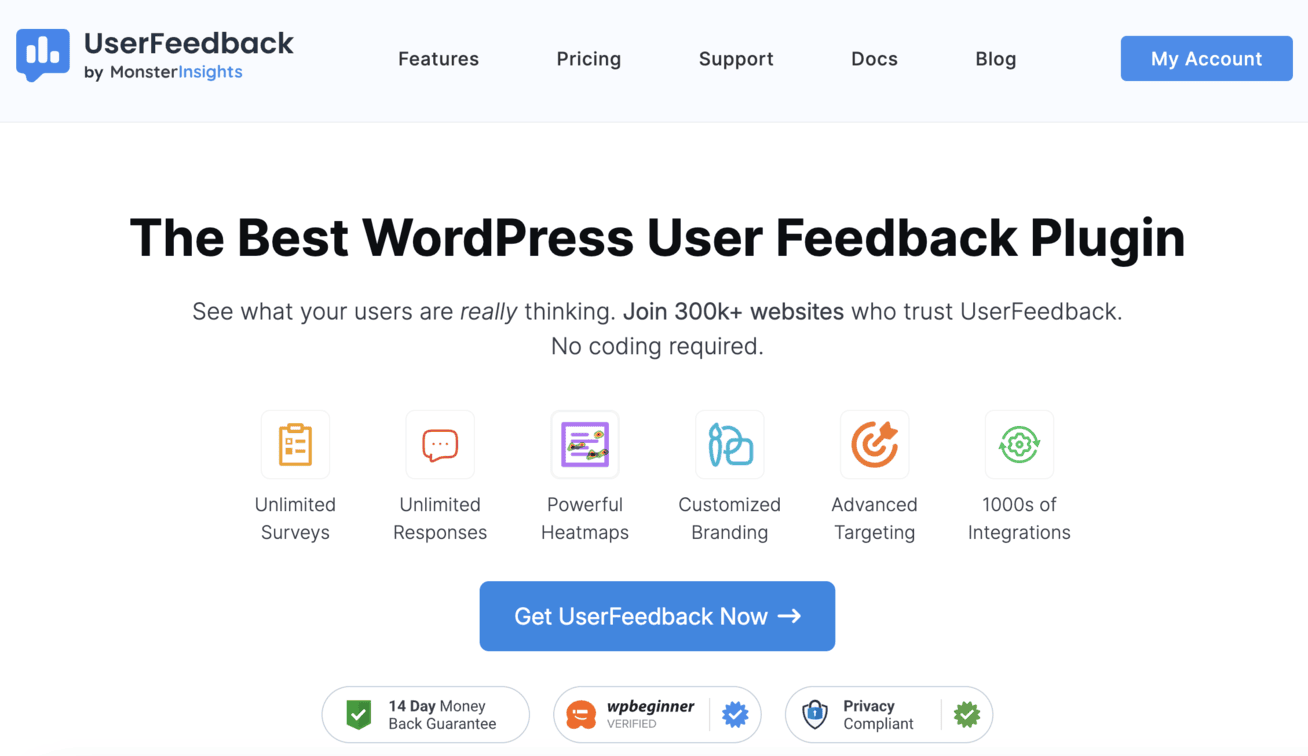Picking the right employee survey questions to ask your employees can be tough. Want to know what your employees really think about working for you? You’re in the right place!
I know how tricky it can be to figure out which questions to ask in employee surveys. You want honest feedback that helps you improve your workplace, but where do you even start?
After years of helping companies create better employee surveys, I’ve learned what works and what doesn’t. The secret isn’t asking hundreds of questions—it’s asking the right ones.
In this guide, I’ll share 89 proven employee feedback survey questions that get real results. Plus, I’ll show you how to use them to actually improve your workplace (because what’s the point of collecting feedback if you don’t act on it?).
Let’s jump right in!
Table of Contents:
- Why Employee Feedback Surveys Matter
- Types of Employee Surveys You Can Use
- The Easiest Way to Create Employee Surveys
- 89 Employee Feedback Survey Questions That Get Results
- How to Create Surveys That Your Employees Will Actually Answer
- What to Do After You Get Survey Results
- FAQs
Why Employee Feedback Surveys Matter
Think of employee surveys as your workplace health check. Without them, you’re basically guessing what your team needs.
Here’s why these surveys are so important:
- You give your people a voice. When you ask for feedback, you show employees their opinions matter. Research shows that 89% of HR managers see successful outcomes from employee surveys.
- You get real data, not just guesses. Instead of wondering if your team is happy, you’ll know for sure. You can track how things change over time and compare your results to other companies.
- You boost engagement. Companies with highly engaged employees are 21% more profitable. When people see you listening and making changes, they become more invested in their work.
- You keep good people longer. About 31% of employees leave within six months of starting. Surveys help you spot problems before they lead to people quitting.
Types of Employee Surveys You Can Use
Before we dive into the questions, let me explain the different types of surveys you might want to try:
1. Employee Satisfaction Surveys
Employee satisfaction surveys check how happy people are with their jobs, pay, benefits, and work environment. Think of them as measuring the “contentment level” of your team.
What they measure:
- Job satisfaction and fulfillment
- Compensation and benefits satisfaction
- Work environment quality
- Management effectiveness
- Work-life balance
When to use them:
- Annually or bi-annually for comprehensive health checks
- After major changes like reorganizations or policy updates
- When you notice signs of dissatisfaction (increased turnover, complaints, etc.)
- To benchmark against industry standards
Real-world example:
Let’s say you’ve noticed more people calling in sick and productivity seems down.
A satisfaction survey might reveal that your open office layout is too noisy, people feel underpaid compared to market rates, or your benefits package doesn’t meet their needs.
UserFeedback offers pre-built satisfaction survey templates that you can customize in minutes if you’re using WordPress. simply select the B2B Satisfaction Survey template, and edit the name and the questions.
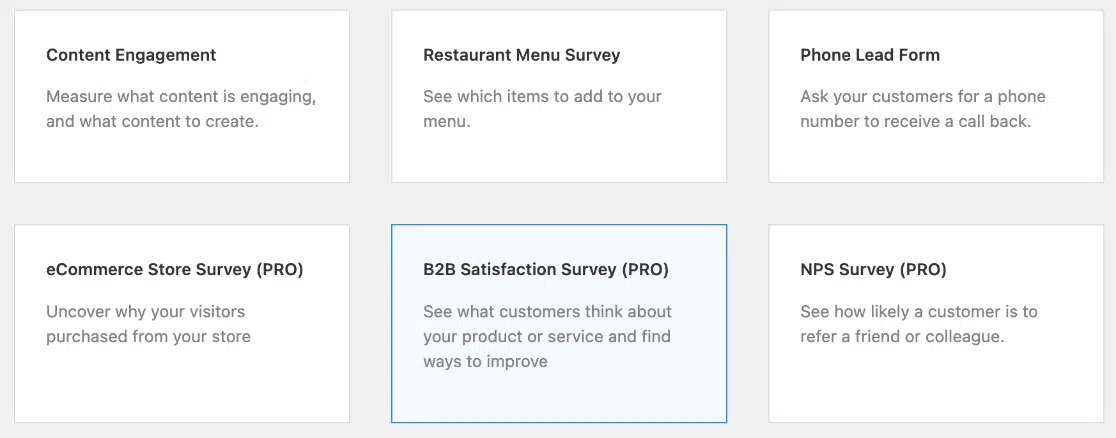
You can also schedule surveys out ahead of time which is great for measuring employee satisfaction levels over time.
UserFeedback makes it incredibly easy to create questions using star ratings:
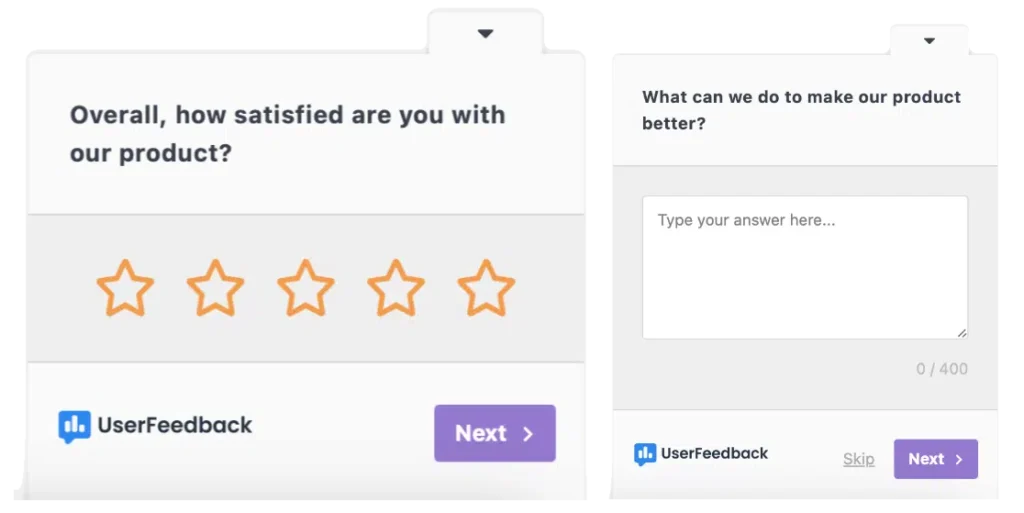
Or likert scales if you want to use a more in-depth scale:
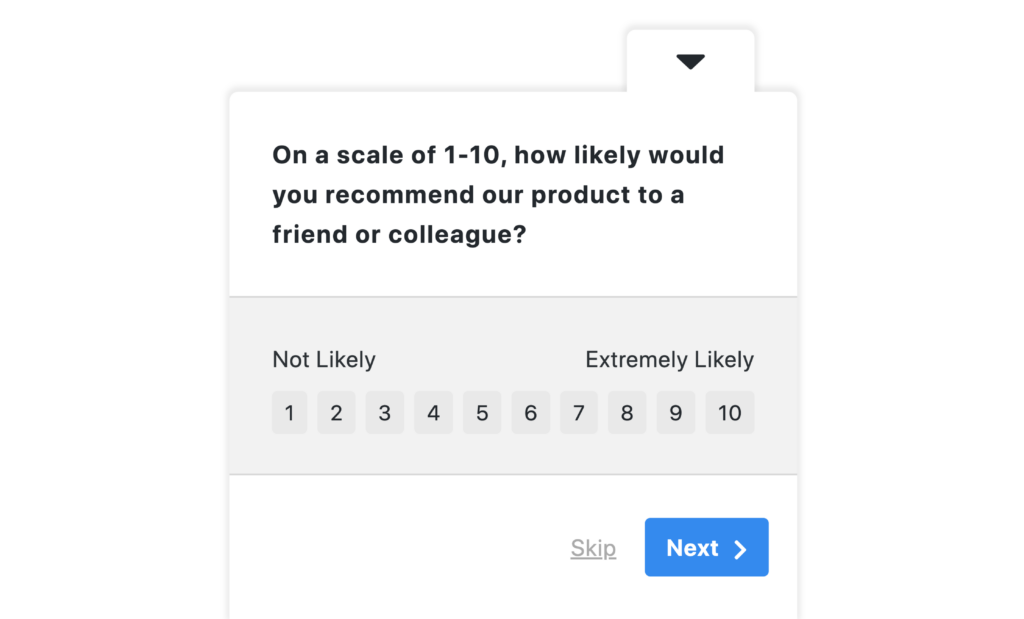
2. Employee Engagement Surveys
These go deeper than satisfaction. They measure how emotionally connected people feel to their work and your company. Engaged employees don’t just show up—they care about doing great work.
What they measure:
- Emotional commitment to the company
- Motivation and enthusiasm for work
- Willingness to go above and beyond
- Connection to company mission and values
- Intent to stay with the organization
When to use them:
- Quarterly or twice yearly to track engagement trends
- Before and after major initiatives or leadership changes
- When you want to understand what drives peak performance
- To identify your most engaged employees (potential leaders/mentors)
Real-world example:
Two employees might both be “satisfied” with their jobs, but one comes in early, volunteers for projects, and actively helps teammates, while the other does the minimum required.
An engagement survey helps you understand what makes the difference and how to create more of those highly engaged employees.
UserFeedback’s conditional logic feature lets you ask follow-up questions based on responses—for example, if someone rates their engagement as low, you can automatically ask what would improve it.
3. Pulse Surveys
These are short, quick surveys (5-10 questions) that you send regularly. They’re like taking your team’s temperature to catch issues early.
What they measure:
- Current mood and sentiment
- Immediate reactions to changes
- Emerging issues before they become big problems
- Progress on specific initiatives
- Quick feedback on recent events or decisions
When to use them:
- Monthly or bi-weekly for regular check-ins
- After team meetings, training sessions, or company announcements
- During busy or stressful periods to monitor well-being
- When implementing new policies or procedures
- To track specific metrics like stress levels or workload
Real-world example:
You just implemented a new project management tool. Instead of waiting six months to ask about it in your annual survey, you send a quick 5-question pulse survey after two weeks:
“How easy is the new tool to use?”
“Is it helping or hurting your productivity?”
“What’s your biggest challenge with it?”
This lets you fix problems immediately instead of letting frustration build.
4. Exit Surveys
These help you understand why people leave, so you can prevent it from happening again.
What they measure:
- Primary reasons for leaving
- What could have prevented their departure
- Quality of their overall experience
- Feedback on management and culture
- Suggestions for improvement
When to use them:
- Every time someone leaves (obviously!)
- Both for voluntary departures and layoffs
- Include questions about the resignation process itself
- Follow up a few months after departure for more honest feedback
Real-world example:
Three people from your marketing team quit within two months.
Exit surveys reveal they all felt micromanaged by their direct supervisor and had no clear path for advancement. This gives you specific, actionable information to address with that manager and the HR team, potentially saving future departures.
Also, check out our guide on 25 Useful Employee Feedback Examples + Tips to Use Them.
The Easiest Way to Create Employee Surveys
Now that you know which types of surveys to use, you might be wondering how to actually create them without spending forever figuring out complicated software.
UserFeedback is the best survey plugin for WordPress users, and I highly recommend it if you’re looking to create engaging surveys in minutes.
Here’s why UserFeedback makes employee surveys so much easier:
- Quick setup. You can have your first employee survey live in under 10 minutes. No technical skills needed.
- Ready-made templates. Instead of starting from scratch, use proven employee satisfaction and engagement survey templates that you can customize for your needs.
- Smart targeting. Show different surveys to different groups automatically—remote workers, specific departments, new hires vs. long-term employees.
- Conditional logic. If someone gives a low satisfaction score, automatically ask follow-up questions like “What would improve your experience?” This gets you deeper insights without making surveys too long.
- Easy-to-read reports. The analytics dashboard shows trends and problem areas in simple charts anyone can understand.
- MonsterInsights integration. This connects your survey data with Google Analytics, so you can see not just what employees say, but how they actually behave on your company sites. It’s the complete picture of employee experience.
The best part? UserFeedback practically runs itself once you set it up. You can schedule regular pulse surveys, automatically send exit surveys, and get real-time results without any manual work.
Get started with UserFeedback today and see how easy employee feedback can be when you have the right tools!
Now that you know which surveys to create and how to create them, let’s jump into the best employee feedback survey questions you should be asking…
89 Employee Feedback Survey Questions That Get Results
Alright, here are the questions that will give you the insights you need. I’ve organized them by category so you can pick what makes sense for your situation.
Employee Satisfaction Questions
- Do you feel valued for your contributions at work?
- Do your managers listen to your feedback?
- Do you get company news when you need it?
- Does management seem to care about your success?
- How transparent do you think management is?
- Is work distributed fairly across your team?
- Do you find your work meaningful?
- Do you see opportunities to advance your career here?
- Do you have what you need to do your job well?
- Are your job responsibilities clear to you?
- Do we make good use of your skills?
- On a scale of 1-10, how happy are you at work?
Employee Engagement Questions
- How do you feel about your day-to-day work?
- Would you recommend this company to friends looking for jobs?
- Do you look forward to coming to work?
- Do you feel proud of the work you do?
- Are you satisfied with your pay and benefits?
- Do you enjoy working with your coworkers?
- Does our company’s mission inspire you?
- Do you feel recognized for your good work?
- Do you see yourself still working here next year?
- Is your work challenging in a good way?
- Have you thought about leaving recently?
- Has anyone at work supported your career goals?
- What changes would keep you more engaged?
Workplace Culture Questions
- Do you feel comfortable sharing ideas with your team?
- Do people work well together here?
- How would you describe our workplace culture?
- Can you be yourself at work?
- Do you feel free to be creative?
- Have you been rewarded for taking smart risks?
- Can you maintain a good work-life balance?
- Do you get helpful feedback about your work?
- Do your ideas get heard and used?
- How would you describe our leadership team?
- Do you think we’re committed to diversity and inclusion?
- Do you believe in the work we do?
- Do you feel like you fit in here?
Growth and Development Questions
- Do you have opportunities to grow in this company?
- Are we using your skills well?
- How does your work connect to our company’s mission?
- Is your work helping you develop new skills?
- Do you feel motivated doing your daily tasks?
- How do your coworkers help you grow?
- Do you have enough control over your work schedule?
- Is the feedback from your manager helpful?
- What could we do to help you grow more?
- What training topics would help you most?
Management and Leadership Questions
- How easy is it to get help when you need it?
- How’s the communication with your direct manager?
- Do you understand how your performance is measured?
- Do you get feedback often enough?
- Does management care about your development?
- Do you feel valued by leadership?
- How could our management be better leaders?
- Does the leadership team inspire you?
- Do you think management is held accountable?
Work Environment Questions
- How would you describe your work environment?
- Do you have the tools and resources you need?
- What’s missing from your work environment?
- Do you feel we value diversity and inclusion?
- What would an ideal work environment look like to you?
Work-Life Balance Questions
- Does your workload allow for good work-life balance?
- How much overtime did you work last month?
- Do you feel your schedule supports work-life balance?
- How often do you work during vacation days?
- How often do you check work email at home?
- Have you missed personal events because of work?
- How can we help improve your work-life balance?
Compensation and Benefits Questions
- Are our benefits and pay clearly explained to you?
- What three benefits matter most to you?
- What benefits are we missing that you’d like to see?
- Do our benefits meet your family’s needs?
- How satisfied are you with your health insurance?
- How satisfied are you with your paid time off?
- What perks would improve employee engagement?
Company Direction Questions
- Do you understand our company’s goals?
- Do you feel in the loop about company news?
- Does your work align with our company’s mission?
- How do you see your role helping the company succeed?
- If you were the CEO, what would you change?
Open-Ended Questions for Deeper Insights
- What changes have you noticed since our last survey?
- How would you like to be involved in company decisions?
- What would help your team work better together?
- How would you describe communication on your team?
- What’s working well that we should keep doing?
- What’s your biggest challenge at work right now?
- How do you describe our company to friends and family?
- What’s one thing we should have asked but didn’t?
How to Create Surveys That Your Employees Will Actually Answer

Now that you have great questions, here’s how to use them effectively:
- Keep It Short and Sweet: Nobody wants to spend an hour on a survey. Stick to 15-25 questions for comprehensive surveys, or 5-10 for quick pulse checks. If people can finish in 10-15 minutes, you’ll get better responses.
- Use Simple Language: Write like you’re talking to a friend. Instead of “How would you rate the efficacy of our organizational communication strategies?” try “How well do we communicate with you?”
- Mix Up Your Question Types: Use a combination of rating scales, multiple choice, yes/no questions, and open-ended questions for detailed feedback.
- Promise (and Keep) Anonymity: People won’t be honest if they think their answers can be traced back to them. Make it clear that responses are anonymous, and mean it.
- Time It Right: Don’t send surveys during crazy busy periods or right before holidays. Give people a heads up that it’s coming so they can plan for it.
Read our full guide on How to Make a Good Survey.
What to Do After You Get Survey Results
Here’s where a lot of companies mess up—they collect all this great feedback and then… nothing happens. I’d highly recommend you to:
- Analyze and Summarize: Look for patterns in the responses. What themes keep coming up? What are your biggest strengths and problem areas?
- Create an Action Plan: Pick the top 3-5 issues to focus on first. You can’t fix everything at once, but you can make meaningful progress on the most important things.
- Communicate Back: Tell your team what you learned and what you plan to do about it. Even if you can’t fix everything immediately, people want to know they were heard.
- Follow Up: Check in periodically to see how your changes are working. Then, survey again to measure your progress.
Pro Tip: The worst thing you can do is survey people and then make no changes. That tells employees their opinions don’t really matter, and they’ll stop participating in future surveys.
There you have it—everything you need to ask employee feedback survey questions that actually make a difference!
Remember, the goal isn’t just to collect data. It’s to use that information to build a workplace where people feel valued, heard, and excited to contribute their best work.
Start with a few key questions that matter most to your situation, keep it simple, and always follow through on what you learn. Your employees will notice, and your workplace will be better for it.
Want to learn more about improving your workplace? Check out these guides:
AI Feedback Analysis 101: A Complete Guide
Guide: The Positive vs. Negative Customer Feedback Loop
16 Best Market Research Tools for Data-Driven Decisions
Real-Time Feedback: A Complete Guide (With Examples)
Don’t forget to follow us for more tips on creating workplaces where people actually want to work!
And don’t forget to follow us on X and Facebook to learn more about collecting user feedback online.
FAQs About Employee Feedback Surveys
How often should I survey my employees?
For comprehensive surveys, once or twice a year is plenty. For quick pulse surveys, you can do them monthly or quarterly. The key is finding a rhythm that gives you useful data without overwhelming people.
What’s a good response rate?
Aim for 70-80% participation. If you’re getting less than 50%, something’s wrong—maybe the survey is too long, people don’t trust it’s anonymous, or they’ve lost faith that anything will change.
Should surveys be mandatory?
I recommend making them voluntary, but strongly encourage. When people choose to participate, they’re more likely to give thoughtful answers.
What if I get negative feedback?
That’s actually good news! Negative feedback tells you exactly what needs fixing. The worst thing is no feedback at all—that usually means people have given up on things getting better.
What’s the difference between satisfaction and engagement?
Satisfaction is about being content with your job. Engagement is about being emotionally invested and motivated to do great work. You want both, but engagement is what really drives performance.
Can I survey remote employees the same way?
Absolutely!
Remote employees often appreciate surveys even more because they have fewer opportunities for informal feedback. Just make sure you ask some remote-specific questions about their work setup and communication needs.

